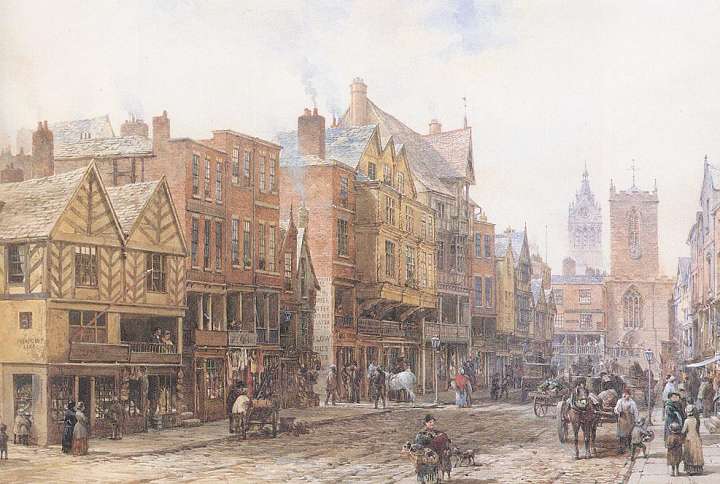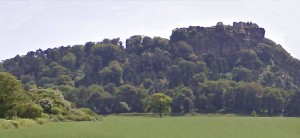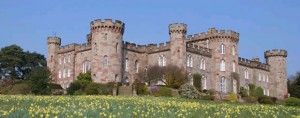Home > Historical Heritage Tours >Kingdom of the Dragon and Lion > Day 2 >
After morning coffee, the group assembles to begin our tour in the Medieval city of Chester situated close to the Welsh border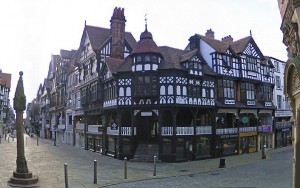 on the banks of the River Dee. The earliest settlement here dates back to the time of the Romans more than 2000 years ago, when it was of major strategic importance to control local Celtic tribes and a large fortified city called Deva Victrix developed at this crossing of the Dee. More than a 1000 years later its position near the border of the fledgling nations of Wales and England, resulted in a Medieval market town developing to replace the early settlement, but even today the fabric of the town retains many of the original Roman walls including an amphitheater.
on the banks of the River Dee. The earliest settlement here dates back to the time of the Romans more than 2000 years ago, when it was of major strategic importance to control local Celtic tribes and a large fortified city called Deva Victrix developed at this crossing of the Dee. More than a 1000 years later its position near the border of the fledgling nations of Wales and England, resulted in a Medieval market town developing to replace the early settlement, but even today the fabric of the town retains many of the original Roman walls including an amphitheater. 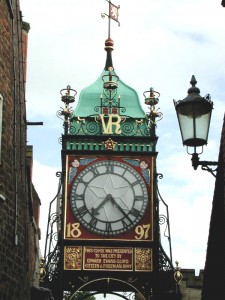 The City is particularly notable for it’s fine medieval architecture and beautiful half-timbered buildings, the most famous of these being the complex known as “The Rows”, a series of covered galleries above street-level shops lining Watergate, East gate, and Bridge Street, the layout of which dates back to the 13th century. Another notable feature of Chester’s wonderful townscape is the Eastgate Clock which was built in 1897 to mark the Silver Jubilee of Queen Victoria. Its intricate iron framework, designed by architect John Douglas, is a marvel of ornate Victorian style.
The City is particularly notable for it’s fine medieval architecture and beautiful half-timbered buildings, the most famous of these being the complex known as “The Rows”, a series of covered galleries above street-level shops lining Watergate, East gate, and Bridge Street, the layout of which dates back to the 13th century. Another notable feature of Chester’s wonderful townscape is the Eastgate Clock which was built in 1897 to mark the Silver Jubilee of Queen Victoria. Its intricate iron framework, designed by architect John Douglas, is a marvel of ornate Victorian style.
Chester’s many beautiful buildings have been the subject of many fine paintings since Victorian 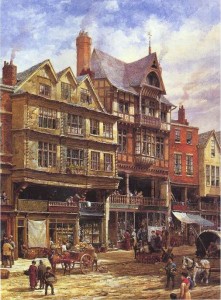 times the most prolific being the work of Louise J Rayner (1832-1924) a gifted and prolific artist who lived in Chester for a number of years and produced numerous fine watercolour studies of the city’s streets and buildings as they were in the 19th century. She most enjoyed visiting old cathedral cities and market towns, and in addition to her Chester, she is also known for her views of London, Hastings, Salisbury, Tewksbury, Warwick, Edinburgh, Wrexham and Shrewsbury. During our visit to the Grosvenor Museum in Chester we will be able to see 23 of her paintings, which comprise the largest collection in the UK and during our tour of the city compare her 19th century street scenes with those of today. We will also take some time to explore many of the City’s historical features including it’s Cathedral which was founded as a Benedictine Abbey as well as it’s ancient defensive walls which surround the city centre.
times the most prolific being the work of Louise J Rayner (1832-1924) a gifted and prolific artist who lived in Chester for a number of years and produced numerous fine watercolour studies of the city’s streets and buildings as they were in the 19th century. She most enjoyed visiting old cathedral cities and market towns, and in addition to her Chester, she is also known for her views of London, Hastings, Salisbury, Tewksbury, Warwick, Edinburgh, Wrexham and Shrewsbury. During our visit to the Grosvenor Museum in Chester we will be able to see 23 of her paintings, which comprise the largest collection in the UK and during our tour of the city compare her 19th century street scenes with those of today. We will also take some time to explore many of the City’s historical features including it’s Cathedral which was founded as a Benedictine Abbey as well as it’s ancient defensive walls which surround the city centre.
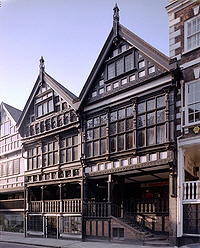 After lunch we will depart the city and travel through the lush green countryside for which the county of Cheshire is notable to the Peckforton hills, a line of rocky sandstone hills in the southern part of the county. There the group will divide into two and either visit Beeston Castle or the gardens of Cholmondley Castle. The later surrounds one of Cheshire’s grandest country houses, that of Cholmondley Castle. Built between 1801 and 1804 by George Cholmondeley, 1st Marquess of Cholmondeley, this baronial manor was designed by the local architect William Turner who was directed by the Marquess to give it the appearance of “an old Gothic Castle. The Marquess of Cholmondeley (pronounced Chum-ley) is a title in the Peerage of the United Kingdom and each Marquess of Cholmondeley is a descendant of Sir Robert Walpole, the first Prime Minister of Great Britain and members of the family have held the post of Hereditary Lord
After lunch we will depart the city and travel through the lush green countryside for which the county of Cheshire is notable to the Peckforton hills, a line of rocky sandstone hills in the southern part of the county. There the group will divide into two and either visit Beeston Castle or the gardens of Cholmondley Castle. The later surrounds one of Cheshire’s grandest country houses, that of Cholmondley Castle. Built between 1801 and 1804 by George Cholmondeley, 1st Marquess of Cholmondeley, this baronial manor was designed by the local architect William Turner who was directed by the Marquess to give it the appearance of “an old Gothic Castle. The Marquess of Cholmondeley (pronounced Chum-ley) is a title in the Peerage of the United Kingdom and each Marquess of Cholmondeley is a descendant of Sir Robert Walpole, the first Prime Minister of Great Britain and members of the family have held the post of Hereditary Lord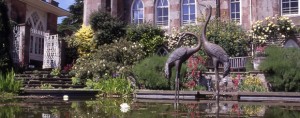 Great Chamberlain for about 200 years. The gardens surrounding the castle provide a lovely mix of colour and height, with intriguing walks around the lake. There is a temple water garden, rose garden, a variety of mixed borders. with a wide variation of foliage and flowers throughout the year. The Cholmondeley Awards for Poets were founded by the late Dowager Marchioness of Cholmondeley in 1966 to recognise the achievement and distinction of individual poets and a visit to see these beautiful lanscaped gardens around this romantic castle are sure to inspire you to put pen to paper to create some special verses of your own.
Great Chamberlain for about 200 years. The gardens surrounding the castle provide a lovely mix of colour and height, with intriguing walks around the lake. There is a temple water garden, rose garden, a variety of mixed borders. with a wide variation of foliage and flowers throughout the year. The Cholmondeley Awards for Poets were founded by the late Dowager Marchioness of Cholmondeley in 1966 to recognise the achievement and distinction of individual poets and a visit to see these beautiful lanscaped gardens around this romantic castle are sure to inspire you to put pen to paper to create some special verses of your own.
The medieval fortress of Beeston Castle, occupies a dramatic position on top of a sandstone crag in the Peckforton Hills and from which are afforded spectacular views across the surrounding countryside. Legend has it that treasure belonging to Richard II lies undiscovered in the castle grounds, but the many searches that have been carried out have failed to find any trace of it, but visitors nevertheless should be amply rewarded for the short climb up to the castle by the views alone, which reputedly extend over 8 counties on a clear day. Prior to our departure from the Peckforton Hills to our hotel, the whole group will be taken to see the ‘Elephant and Castle of Peckforton” A large Sculpture carved from a single block of red sandstone in 1859 by a local stonemason whilst he worked on nearby Peckforton Castle. This remarkable sandstone sculptured elephant has a tasseled saddle which supports a three tiered castle which has a turreted gatehouse and a keep with turrets each corner.
Day 1 Highlights:
- Chester
- Amphitheater
- The Rows
- Eastgate Clock
- Grosvenor Museum
- Chester Cathedral
- Defensive Walls
- Cholmondley Castle
- Beeston Castle
- Peckforton Hills
- Elephant and Castle of Peckforton




